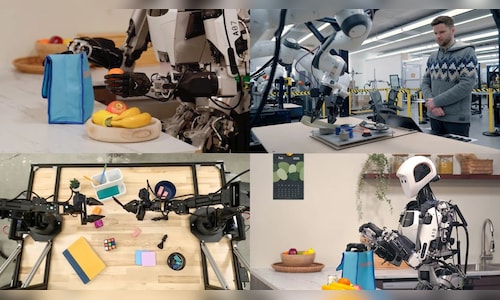This cutting-edge AI model, built on Gemini 2.0, is designed to bridge the gap between digital intelligence and real-world action. In simple terms, it allows robots to see, understand, and interact with their surroundings more effectively than ever before. Let’s break down what makes Gemini Robotics a game-changer.
What is Gemini Robotics?
At its core, Gemini Robotics is an advanced vision-language-action (VLA) model. Unlike traditional AI models that focus on analysing data, Gemini Robotics can control robots, enabling them to perform real-world tasks. It processes information from various sources—like images and spoken instructions—and translates it into actions.
But DeepMind didn’t stop there. They also introduced Gemini Robotics-ER, an enhanced version with a deeper understanding of space and movement. This means roboticists can integrate it into their own systems to improve how machines navigate and interact with their environment.
What can Gemini Robotics do?
The goal of Gemini Robotics is to make robots more adaptable, interactive, and precise. Here’s how:
General Intelligence: The model can handle unfamiliar situations and new tasks, learning on the go. It doesn’t need specific training for every scenario—it just figures things out, much like a human would.
Real-Time Interaction: Robots powered by Gemini Robotics can understand and respond to spoken commands in natural language. Whether it’s in English, Spanish, or another language, these robots can follow instructions on the fly.
Dexterity and Precision: Robots often struggle with delicate tasks, but Gemini Robotics changes that. It can handle complex, multi-step actions—think folding origami or packing items neatly into a bag.
A step towards human-like robots
A major highlight of Gemini Robotics is its adaptability. It’s not just designed for one type of robot—it can work across different machines. For example, it’s being tested on Apptronik’s Apollo humanoid robot, but it’s also compatible with other robotic platforms like ALOHA 2 and Franka arms. This flexibility makes it a powerful tool for future advancements in robotics.
Safety First: AI with Caution
While Gemini Robotics aims to make robots more useful, safety remains a top priority. Google DeepMind has built-in safeguards to prevent accidents, ensuring robots don’t make unsafe decisions. The system even incorporates a ‘Robot Constitution’—a set of AI-driven rules inspired by Isaac Asimov’s Three Laws of Robotics—to guide robots in making responsible choices.
What’s next?
Google DeepMind is already collaborating with industry leaders like Boston Dynamics, Agility Robotics, and Enchanted Tools to refine and expand Gemini Robotics’ capabilities. Trusted testers are helping to push its limits, ensuring it meets real-world needs before broader release.
The introduction of Gemini Robotics marks an exciting step toward AI-powered robots that can seamlessly assist in everyday life—whether at home, in workplaces, or even in medical settings. As technology continues to evolve, we may soon see robots that aren’t just smart, but genuinely helpful and safe for human interaction.


